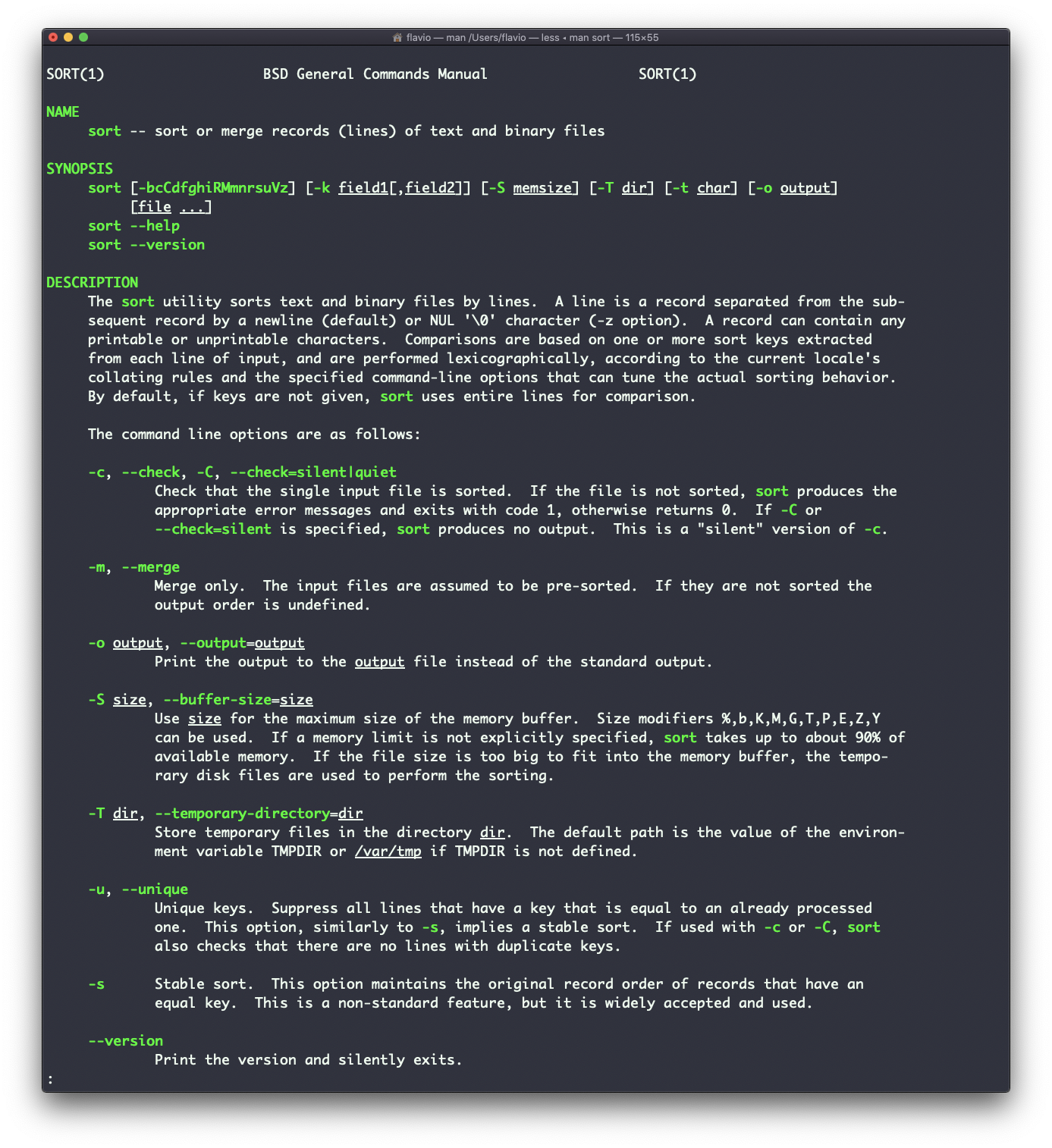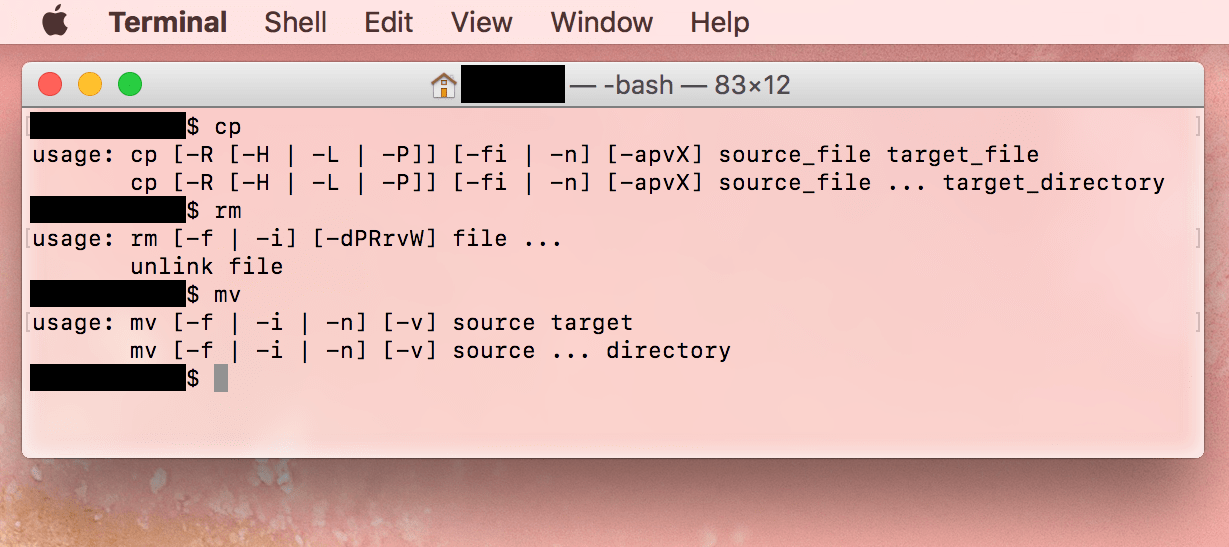Terminal Commands Manual
- Terminal Commands Macbook
- Terminal Commands Manual Page
- Terminal Commands For Mac
- Terminal Commands Manual Download
- Terminal Commands Mac Delete
The man command is a built-in manual for using Linux commands. It allows users to view the reference manuals of a command or utility run in the terminal. The man page (short for manual page) includes a command description, applicable options, flags, examples, and other informative sections. Man command Manual. Prints to the screen the manual pages for the command. This includes the proper syntax and a description of how that command works. Clear: Empties the terminal window of previous commands and output. Cp Copies the file or directory at source-path and puts it in the target-path. Jul 02, 2021 How to use the commands manual. The key to Terminal wisdom is the man command. It summons manual (or man) pages for almost any command; they’re the equivalent of a help system for the command line. In fact, man itself is a command, whose role is to format and display this documentation. First, launch Terminal (in your /Applications/Utilities. AT Commands User Manual 7 1 Introduction 1.1 Purpose of the document This document describes the messages exchanged between an external application and the N701 mobile station based on AT commands in order to control incoming / outgoing calls, SMS administration, mobile station behavior and GPRS connections. 1.2 Terms and Abbreviations.
body>
How can you learn about all those mysterious Terminal commands, such as ls or cd? Is it some kind of arcane knowledge, handed down only to initiates after grueling initiations? Well, no. Actually, anyone can learn about Terminal commands, if they know where to look.
How to use the commands manual
The key to Terminal wisdom is the man command. It summons manual (or man) pages for almost any command; they're the equivalent of a help system for the command line. In fact, man itself is a command, whose role is to format and display this documentation.
First, launch Terminal (in your /Applications/Utilities folder). Then, if you type man pwd, for example, Terminal will display the man page for the pwd command.
man page for the pwd command.All man pages have a common format. They begin with name (the name of the command) and a brief description of what it does. The pwd command I looked at above shows the following:

pwd -- return working directory name
Next comes synopsis, which shows the command options, or flags, that you can use with it. For pwd, there are two options: -L and -P. These options are explained in the description section:
As you can see here, each of the two options is explained, and a final sentence tells you that the command assumes that the -L option is desired if no other option (and there's only one) is specified.
Terminal Commands Macbook
As you work from the command line, you'll find that reading up on the options available for different commands is really important. You'll learn the myriad ways you can use these tools, and some man pages also contain examples to help you understand them.
How to scroll through man pages
When you look at a man page, you do so in Terminal through another command, called a pager; by default, this is the less command. What a pager command does is allow you to view content in Terminal page by page, or line by line. When you're viewing a man page, you will most often not see the entire page at once. You'll need to page down to see more.
There are two ways to do this with less:
- If you press Return, the page will move down one line.
- If you press the spacebar, the page will scroll one page (the number of lines visible in your Terminal window).
- You can tell that there's more to come by the
:(colon) visible at the bottom of the window.
Try it on your Mac: Open Terminal, type man ls, then press Return. The ls command's man page is quite long, and you'll need to press the spacebar several times to get to the bottom.
Sometimes, when you're viewing a man page, you need to go back up and look at something that's no longer visible. Depending on your Terminal settings, you may be able to scroll the Terminal window. If not, press Control-B to go back a page, and the spacebar, or Control-F, to go forward a page.
When you get to the end of a man page, you'll see this: (END). You'll notice that you can't do anything at that point; you need to quit the less command; do this by pressing the Q key.

Other ways to read man pages

If you don't want to read man pages in Terminal, there are other ways to view this content. You can find man pages on the web. Just type man and the name of a command into your favorite search engine, and you'll get plenty of hits. Apple has a documentation repository with man pages here. You can click Alphabetic Index to get a list of all commands, then search for the one you want. Apple's man pages are useful because a popup menu near the top of the page lets you choose an OS X version, so if you need to see the man page for an older version of OS X, you can do so.
No matter which route you choose, man pages open the door to a goldmine of information about the command line. Use them and you'll learn all the ins and outs of the commands you use.
More from MSI Gaming Australia
Join the newsletter!
Introduction
The Linux command line offers a wealth of power and opportunity. If your memory is like mine then you find it hard to remember a large number of details. Fortunately for us there is an easy to use resource that can inform us about all the great things we can do on the command line. That's what we're going to learn about in this section. I know you're keen and eager to get stuck into doing stuff, and we'll get started on that in the next section, I promise, first we need to learn how to use Manual pages however.
So what are they exactly?
The manual pages are a set of pages that explain every command available on your system including what they do, the specifics of how you run them and what command line arguments they accept. Some of them are a little hard to get your head around but they are fairly consistent in their structure so once you get the hang of it it's not too bad. You invoke the manual pages with the following command:
man <command to look up>
- man ls
- Name
- ls - list directory contents
- Synopsis
- ls [option] ... [file] ...
- Description
- List information about the FILEs (the current directory by default). Sort entries alphabetically if none of -cftuvSUX nor --sort is specified.
- Mandatory arguments to long options are mandatory for short options too.
- -a, --all
- do not ignore entries starting with .
- -A, --almost-all
- do not list implied . and ..
- ...
Let's break it down:
- Line 3 tells us the actual command followed by a simple one line description of it's function.
- Lines 6 is what's called the synopsis. This is really just a quick overview of how the command should be run. Square brackets ( [ ] ) indicate that something is optional. (option on this line refers to the command line options listed below the description)
- Line 9 presents us with a more detailed description of the command.
- Line 11 onwards Below the description will always be a list of all the command line options that are available for the command.
To exit the man pages press 'q' for quit.
Searching
It is possible to do a keyword search on the Manual pages. This can be helpful if you're not quite sure of what command you may want to use but you know what you want to achieve. To be effective with this approach, you may need a few goes. It is not uncommon to find that a particular word exists in many manual pages.
man -k <search term>
If you want to search within a manual page this is also possible. To do this, whilst you are in the particular manual page you would like to search press forward slash '/' followed by the term you would like to search for and hit 'enter' If the term appears multiple times you may cycle through them by pressing the 'n' button for next.
More on the Running of Commands
A lot of being proficient at Linux is knowing which command line options we should use to modify the behaviour of our commands to suit our needs. A lot of these have both a long hand and short hand version. eg. Above you will notice that to list all directory entries (including hidden files) we can use the option -a or --all (remember from last section what files and directories beginning with a . are?). The long hand is really just a more human readable form. You may use either, they both do the same thing. One advantage of using long hand is that it can be easier for you to remember what your commands are doing. One advantage of using shorthand is that you can chain multiple together easier.
- pwd
- /home/ryan
- ls -a
- ls --all
- ls -alh
Terminal Commands Manual Page
Look up the man page for ls to find out what that last command is doing.
Terminal Commands For Mac
As you can see, long hand command line options begin with two dashes ( -- ) and short hand options begin with a single dash ( - ). When we use a single dash we may invoke several options by placing all the letters representing those options together after the dash. (There are a few instance where a particular option requires an argument to go with it and those options generally have to be placed separately along with their corresponding argument. Don't worry too much about these special cases for now though. We'll point them out as we encounter them.)
Summary
Terminal Commands Manual Download
Activities
Right, now let's put this stuff into practice. Have a go at the following:

Terminal Commands Mac Delete
- Have a skim through the man page for ls. Have a play with some of the command line options you find there. Make sure you play with a few as combinations. Also make sure you play with ls with both absolute and relative paths.
- Now try doing a few searches through the man pages. Depending on your chosen terms you may get quite a large listing. Look at a few of the pages to get a feel for what they are like.